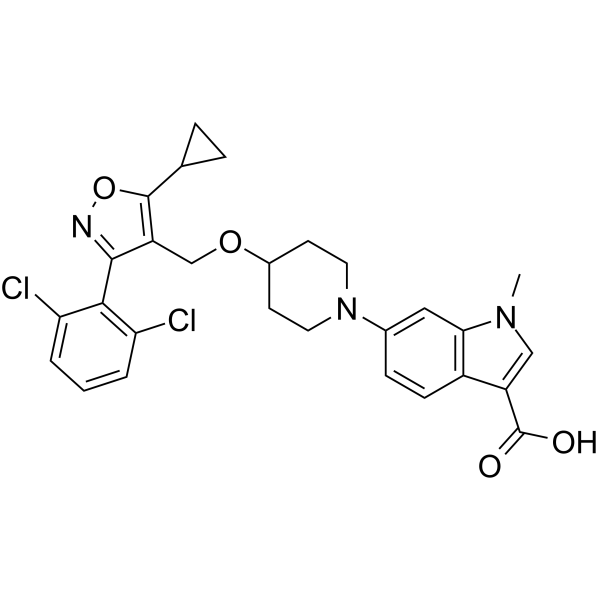| Description: |
LY2562175 is a potent and selective FXR agonist with an EC50 of 193 nM. |
| Target: |
EC50: 193 nM (FXR) |
| In Vivo: |
LY2562175 causes a dose-dependent decrease in serum cholesterol and serum triglycerides. At a dose of 10 mg/kg, the decrease in cholesterol with LY2562175 is 80% below vehicle-treated animals, and the decrease in serum triglycerides is 76% from control group. The ED50 for serum cholesterol is determined to be 2 and 3.4 mg/kg for serum triglycerides. Treatment of female ZDF rats with LY2562175 results in a dose dependent lowering of plasma triglycerides in the fasted and nonfasted states. When administered as a fixed dose combination with rosiglitazone, LY2562175 further lowers fasted and nonfasted plasma triglycerides. FPLC fractionation of the lipoproteins reveals that LY2562175 treatment results in a reduction in vLDL-C and a dramatic increase in HDL-c in this animal model[1]. |
| In Vitro: |
LY2562175 promotes transcriptional activation of human FXR in a cell-based co-transfection assay with an EC50 of 193 nM. LY2562175 promotes recruitment of a peptide from the nuclear receptor interaction domain of the coactivator SRC-1 with a relative EC50 of 121 nM and 93.5% efficacy as compare to GW4064[1]. |
| Kinase Assay: |
LY2562175 is tested in concentration-response curves by an FXR-SRC-1 Cofactor Recruitment assay using the Alpha Screen technology according to the manufacturer instructions. Briefly, purified 6-HIS-tagged human FXR ligand-binding domain (amino acids 242-472), purified GST-tagged human SRC-1 nuclear receptor-interacting domain (amino acids 220-394), Nickel Chelate donor beads and Anti-GST antibody acceptor beads are mixed together and 12 μL per well is aliquoted into 384 well plates. Add LY2562175 in 3 μL per well for a total assay volume of 15 μL and incubate at room temperature in the dark for 4 hours. After incubation, LY2562175 that binds FXR and induces the interaction between the FXR and SRC-1 will bring the two bead types into proximity generating luminescence that is quantified using a Packard Fusion instrument. Calculate EC50 values for LY2562175[1]. |
| Animal Administration: |
To assess the potency and efficacy of LY2562175 in vivo, studies are conducted in 8 week old, male LDLR null mice fed a “Western” diet. Animals are allowed to acclimate to the high fat/high cholesterol chow TD88137 (containing 0.15% cholesterol and 42% fat) for 2 weeks prior to the study. Animals are divided into groups of six and dosed once daily for 1 week by gavage with solutions of LY2562175 in situ sodium salt or with vehicle (5% Solutol, 5% EtOH, 1 wt %/v CMC) at a dose volume of 5 mL/kg. On the seventh day, animals are bled by cardiac puncture under anesthesia with CO2. Serum is prepared from individual animals for determination of cholesterol and triglycerides by enzymatic analysis. Pooled samples from each treatment group are used for determination of lipoprotein subtypes. ED50 values (dose producing half-maximal effect) for the decrease in serum cholesterol and triglycerides are determined by nonlinear regression analysis[1]. |
| References: |
[1]. Genin MJ, et al. Discovery of 6-(4-{[5-Cyclopropyl-3-(2,6-dichlorophenyl)isoxazol-4-yl]methoxy}piperidin-1-yl)-1-methyl-1H-indole-3-carboxylic Acid: A Novel FXR Agonist for the Treatment of Dyslipidemia. J Med Chem. 2015 Dec 24;58(24):9768-72. |






















